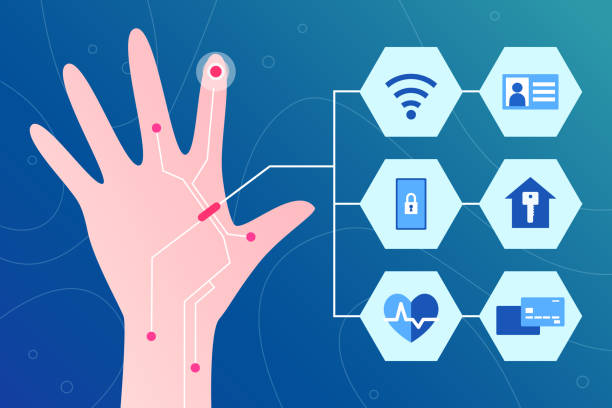
20 Apr Would you be willing to microchip your special needs loved one?
Is microchipping the next best technology for those with special needs? Let’s explore this a bit.
If someone told you chip implant technology is near completely safe, would you consider this for you as a person with special needs or for your special needs loved one? This technology exists today and is typically the size of a grain of rice, which can be safely implanted into the tip of your thumb or other parts of your hand.

Sub dermal microchip implant or transponder implanted into human hand – 3d illustration
Without hesitancy, I would absolutely be excited to try this for our son, Kevin. Convincing my wife, Ruth might be a different story. That might take a bit of convincing.
In a previous blog (Safety for Special Needs), we briefly mentioned wearable devices as a way of tracking or identifying your special needs loved one. Several wearable devices on the market have additional capabilities (think fitness monitoring, etc.) and benefits as well. I suggested that anything ‘wearable’ is not a doable option for Kevin, as these things tend to bother and irritate him, and it is likely he would remove it. A chip implant would obviously make it impossible for him to remove.
Let’s set aside ‘tracking’ for the moment, as there are currently limitations in that specific capability for chip implants, specifically given the need to recharge the battery more frequently. We will focus on this feature as relates to chip implants in a future blog.
So, let’s examine what other types of challenges chip implants might help solve
Here are some that come to mind:
- Personal Identification
- Storing of emergency contact details
- Medical information
- Gathering and storing of real-time vitals (heart rate patterns, blood pressure, etc.)
- Storing of passwords, tickets and cards
- Access and entry to your home
Possible use cases are numerous but for now I will focus on just these six.
Personal Identification
Regarding Kevin, it is never a guarantee he will have a wallet or any other wearable ID on him. Given he is nonverbal and sometimes confused, chances are he might not provide ID at someone’s request. If he was lost and confused, it would be ideal if someone in law enforcement could identify him quickly and provide needed assistance.
Storing of emergency contact details
The same as with personal identification info, knowing someone’s emergency contact detail would be extremely helpful, especially during a frightening incident.
Medical information
Imagine a situation where you as a special needs person or your special needs loved one are whisked away to a hospital emergency room. And without the immediate knowledge of your caretaker or loved one. Knowing your medical situation and history upon arrival could significantly expedite the hospital check in process and provide the medical team with critical data to better address your emergency medical situation. In some situations, this can absolutely save your life.
Gathering and storing of real-time vitals (heart rate patterns, blood pressure, etc.)
While this info may not be as critical in some cases, I can see it being a very proactive ‘nice to have’ file of information to help your doctors and medical advisors better to define appropriate diagnosis and recommendations for preventative care. While technology for these capabilities exist currently in the form of wearable devices (Apple watches, Fitbits, etc.), it is not always a good option for someone that is nonverbal or at risk to remove the device
Storing of passwords, tickets or cards
While password storing is not something important to us or relevant to Kevin, I can see the potential benefit for others; those that are able to use technology on a regular basis. However, I do indeed imagine benefits for us if we had the opportunity to store cards (credit cards, library cards, insurance cards, etc.) on Kevin’s implant chip. The same goes for storing of tickets (admission tickets, etc.).
Access and entry to your home
While this feature also might belong more on the ‘nice to have’ list versus critical needs list, I would agree this would allow some convenience. It eliminates the risk of losing keys or trying to coordinate door locks. However, I’d personally look more toward facial recognition or other keyless entry technologies to address this need.
Does this all sound too good to be true?
While these features and capabilities seem quite interesting and its possibilities exciting, some obvious obstacles and loopholes immediately come to mind. How would someone in law enforcement know Kevin had a chip inserted under his skin? And the biggest challenge is, how many (if any), local police departments or other law enforcement agencies have access to this type of technology to even scan someone with a chip implant?
Just to support this technology and infrastructure would require a huge investment by taxpayers. It would also require a tremendous public safety awareness effort, along with training to accommodate this type of technical capability.
There are companies out there today that are working hard to make this technology more mainstream in our society. In Sweden, they seem to be more embracing of the capabilities and art of the possible. Swedes are leading the way. One reason might be they are less concerned than others (including the US) about data privacy.
While many that use this technology in Sweden appear to be more focused on its use as a matter of gaining efficiencies and providing convenience, I see this more as an enabler for providing high value to the special needs community. Some companies here in the US are looking closely at this technology for use with dementia patients. This aligns more with my thinking as our use case is quite similar.
Other risks to consider
Regardless of how safe this technology and procedure may appear, there is undeniable risk, including risk of infection and risk of chip parts eventually corroding in your body. And what about “hacking”? After all, this is technology that is very software intensive, meaning it will need to be “programmed” and “updated” as changes, fixes and improvements become available. This can introduce opportunities for security vulnerabilities to exploit the devices and their associated infrastructure.
Just the thought of all this can be a bit overwhelming and potentially prevent wider adoption.
But I stand by my opening statement and would openly embrace the opportunity to try this with Kevin. For our situation, I think the potential benefits far outweigh the potential risks.
We’d like to hear your thoughts either directly contact us or encourage you to comment via our social community.


